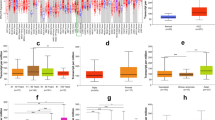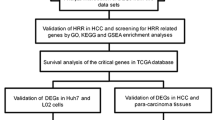Abstract
Background
PARP1-binding protein (PARPBP/PARI/C12orf48), a negative regulator of homologous recombination (HR), has been suggested to function as an oncogene in cervical, lung, and pancreatic cancer.
Objective
To investigate the expression profile of PARPBP and its role in hepatocellular carcinoma (HCC).
Methods
Using data from the Cancer Genome Atlas and Human Protein Atlas databases, PARPBP expression level and its clinical implication in HCC were identified by t test and Chi-square test. The prognostic value of PARPBP in HCC was evaluated by Kaplan–Meier method, Cox regression analysis, and nomogram. Gene set enrichment analysis (GSEA) was used to screen biological pathways correlated with PARPBP expression in HCC.
Results
PARPBP was significantly upregulated in HCC tissues compared with normal liver tissues (P < 0.05). High PARPBP expression was significantly associated with elevated serum AFP level, vascular invasion, poor tumor differentiation, and advanced TNM stage (all P < 0.05). Kaplan–Meier analyses suggested that upregulation of PARPBP was correlated with worse overall survival (OS) and recurrence-free survival (RFS) in HCC. Multivariate analyses further confirmed that PARPBP upregulation was an independent indicator of poor OS and RFS (all P < 0.05). The prognostic nomograms based on PARPBP mRNA expression and TNM stage were superior to those based on the TNM staging system alone (all P < 0.05). Besides, PARPBP DNA copy gain and miR-139-5p downregulation were associated with PARPBP upregulation in HCC. GSEA revealed that “cell cycle,” “HR,” “DNA replication,” and “p53 signaling” pathways were enriched in high PARPBP expression group.
Conclusion
PARPBP may be a promising prognostic biomarker and candidate therapeutic target in HCC.









Similar content being viewed by others
References
Bray F, Ferlay J, Soerjomataram I, et al. Global cancer statistics 2018: GLOBOCAN estimates of incidence and mortality worldwide for 36 cancers in 185 countries. CA Cancer J Clin. 2018;68:394–424.
Rich NE, Yopp AC, Singal AG. Medical management of hepatocellular carcinoma. J Oncol Pract. 2017;13:356–364.
Su C. Survivin in survival of hepatocellular carcinoma. Cancer Lett. 2016;379:184–190.
O’Connor KW, Dejsuphong D, Park E, et al. PARI overexpression promotes genomic instability and pancreatic tumorigenesis. Cancer Res. 2013;73:2529–2539.
Moldovan GL, Dejsuphong D, Petalcorin MI, et al. Inhibition of homologous recombination by the PCNA-interacting protein PARI. Mol Cell. 2012;45:75–86.
Piao L, Nakagawa H, Ueda K, et al. C12orf48, termed PARP-1 binding protein, enhances poly(ADP-ribose) polymerase-1 (PARP-1) activity and protects pancreatic cancer cells from DNA damage. Genes Chromosom Cancer. 2011;50:13–24.
Jinawath N, Chamgramol Y, Furukawa Y, et al. Comparison of gene expression profiles between Opisthorchis viverrini and non-Opisthorchis viverrini associated human intrahepatic cholangiocarcinoma. Hepatology. 2006;44:1025–1038.
Tamura K, Furihata M, Tsunoda T, et al. Molecular features of hormone-refractory prostate cancer cells by genome-wide gene expression profiles. Cancer Res. 2007;67:5117–5125.
Taniwaki M, Daigo Y, Ishikawa N, et al. Gene expression profiles of small-cell lung cancers: molecular signatures of lung cancer. Int J Oncol. 2006;29:567–575.
van Dam S, Cordeiro R, Craig T, et al. GeneFriends: an online co-expression analysis tool to identify novel gene targets for aging and complex diseases. BMC Genomics. 2012;13:535.
Tang Z, Li C, Kang B, et al. GEPIA: a web server for cancer and normal gene expression profiling and interactive analyses. Nucl Acids Res. 2017;45:W98–W102.
Cerami E, Gao J, Dogrusoz U, et al. The cBio cancer genomics portal: an open platform for exploring multidimensional cancer genomics data. Cancer Discov. 2012;2:401–404.
Uhlen M, Oksvold P, Fagerberg L, et al. Towards a knowledge-based Human Protein Atlas. Nat Biotechnol. 2010;28:1248–1250.
Paraskevopoulou MD, Georgakilas G, Kostoulas N, et al. DIANA-microT web server v5.0: service integration into miRNA functional analysis workflows. Nucl Acids Res. 2013;41:W169–W173.
Sticht C, De La Torre C, Parveen A, et al. miRWalk: an online resource for prediction of microRNA binding sites. PLoS ONE. 2018;13:e0206239.
Camp RL, Dolled-Filhart M, Rimm DL. X-tile: a new bio-informatics tool for biomarker assessment and outcome-based cut-point optimization. Clin Cancer Res. 2004;10:7252–7259.
Northen A, Asendorf T, Walson PD, et al. Diagnostic value of alpha-1-fetoprotein (AFP) as a biomarker for hepatocellular carcinoma recurrence after liver transplantation. Clin Biochem. 2018;52:20–25.
Hou SC, Xiao MB, Ni RZ, et al. Serum GP73 is complementary to AFP and GGT-II for the diagnosis of hepatocellular carcinoma. Oncol Lett. 2013;6:1152–1158.
Ma J, Gao M, Lu Y, et al. Gain of 1q25-32, 12q23-24.3, and 17q12-22 facilitates tumorigenesis and progression of human squamous cell lung cancer. J Pathol. 2006;210:205–213.
Poniah P, Mohd Zain S, Abdul Razack AH, et al. Genome-wide copy number analysis reveals candidate gene loci that confer susceptibility to high-grade prostate cancer. Urol Oncol. 2017;35:545e1–545e11.
Eden A, Gaudet F, Waghmare A, et al. Chromosomal instability and tumors promoted by DNA hypomethylation. Science. 2003;300:455.
Catela Ivkovic T, Voss G, Cornella H, et al. microRNAs as cancer therapeutics: a step closer to clinical application. Cancer Lett. 2017;407:113–122.
Wong CC, Wong CM, Tung EK, et al. The microRNA miR-139 suppresses metastasis and progression of hepatocellular carcinoma by down-regulating Rho-kinase 2. Gastroenterology. 2011;140:322–331.
Hua S, Lei L, Deng L, et al. miR-139-5p inhibits aerobic glycolysis, cell proliferation, migration, and invasion in hepatocellular carcinoma via a reciprocal regulatory interaction with ETS1. Oncogene. 2018;37:1624–1636.
Chen J, Yu Y, Chen X, et al. MiR-139-5p is associated with poor prognosis and regulates glycolysis by repressing PKM2 in gallbladder carcinoma. Cell Prolif. 2018;51:e12510.
Agosta C, Laugier J, Guyon L, et al. MiR-483-5p and miR-139-5p promote aggressiveness by targeting N-myc downstream-regulated gene family members in adrenocortical cancer. Int J Cancer. 2018;143:944–957.
Liu J, Li C, Jiang Y, et al. Tumor-suppressor role of miR-139-5p in endometrial cancer. Cancer Cell Int. 2018;18:51.
Krstic J, Galhuber M, Schulz TJ, et al. p53 as a dichotomous regulator of liver disease: the dose makes the medicine. Int J Mol Sci. 2018;19:921.
Khemlina G, Ikeda S, Kurzrock R. The biology of hepatocellular carcinoma: implications for genomic and immune therapies. Mol Cancer. 2017;16:149.
Hanahan D, Weinberg RA. Hallmarks of cancer: the next generation. Cell. 2011;144:646–674.
Burkovics P, Dome L, Juhasz S, et al. The PCNA-associated protein PARI negatively regulates homologous recombination via the inhibition of DNA repair synthesis. Nucl Acids Res. 2016;44:3176–3189.
Errico A, Deshmukh K, Tanaka Y, et al. Identification of substrates for cyclin dependent kinases. Adv Enzyme Regul. 2010;50:375–399.
Baugh EH, Ke H, Levine AJ, et al. Why are there hotspot mutations in the TP53 gene in human cancers? Cell Death Differ. 2018;25:154–160.
Author information
Authors and Affiliations
Corresponding author
Ethics declarations
Conflict of interest
The authors declare that they have no competing interests.
Additional information
Publisher's Note
Springer Nature remains neutral with regard to jurisdictional claims in published maps and institutional affiliations.
Rights and permissions
About this article
Cite this article
Yu, B., Ding, Y., Liao, X. et al. Overexpression of PARPBP Correlates with Tumor Progression and Poor Prognosis in Hepatocellular Carcinoma. Dig Dis Sci 64, 2878–2892 (2019). https://doi.org/10.1007/s10620-019-05608-4
Received:
Accepted:
Published:
Issue Date:
DOI: https://doi.org/10.1007/s10620-019-05608-4




